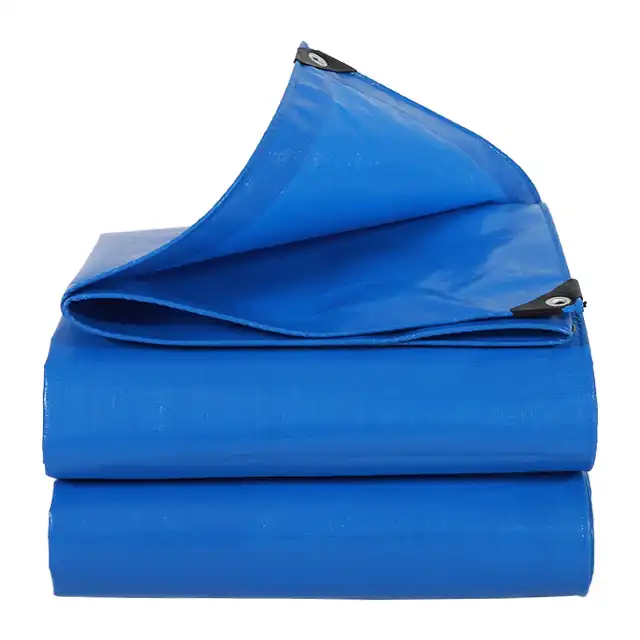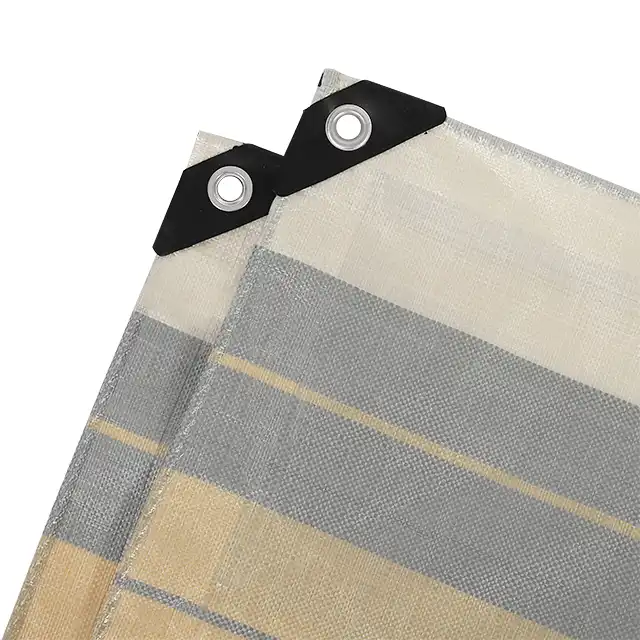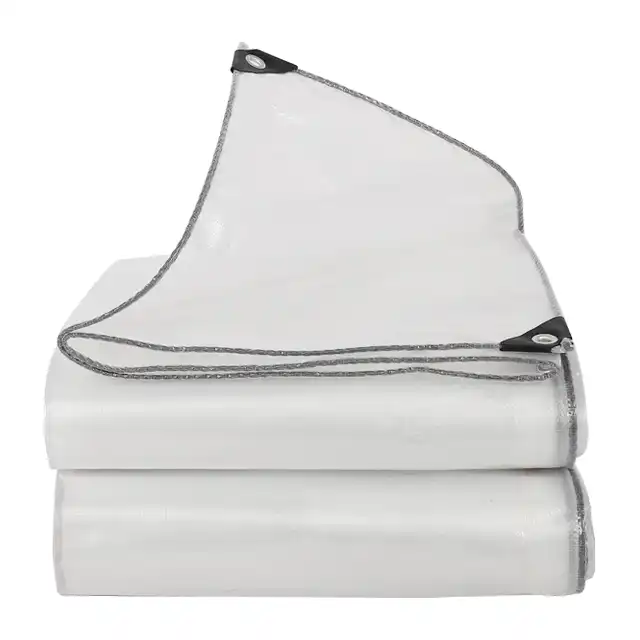How Will Polyethylene Tarpaulins Market Grow in 2025?
The polyethylene tarpaulins market is poised for substantial growth in 2025, driven by increasing demand across multiple industries including construction, agriculture, transportation, and disaster relief. Industry analysts predict a compound annual growth rate (CAGR) of 4.8% through 2025, with the global market value expected to exceed $7.2 billion. This expansion is fueled by polyethylene tarpaulins' versatility, durability, and cost-effectiveness compared to alternative materials. Innovation in manufacturing processes and increasing environmental awareness are also contributing factors, as leading manufacturers like Linyi Shengde Plastic Co., Ltd. continue to develop more sustainable and high-performance tarpaulin products to meet evolving market demands.
Driving Factors Behind the Polyethylene Tarpaulins Market Expansion

Increasing Applications Across Multiple Industries
The polyethylene tarpaulins market is experiencing unprecedented growth due to its expanding applications across various industries. In the construction sector, these versatile coverings have become essential for protecting building materials, creating temporary shelters, and securing construction sites from environmental elements. The agriculture industry increasingly relies on polyethylene tarpaulins for greenhouse coverings, crop protection, and storage solutions. Farmers appreciate the waterproof nature and UV resistance that quality tarpaulins provide, extending the life of their equipment and protecting harvests. Transportation companies utilize truck covers made from polyethylene tarpaulins to secure cargo during transit, preventing damage from rain, wind, and debris. As Linyi Shengde Plastic Co., Ltd. demonstrates with their diverse product range, modern polyethylene tarpaulins serve numerous purposes including packing materials, wood cover, goods protection, car canopies, sun shade covers, picnic pads, leisure tents, and impermeable tarps for aquaculture. The versatility of these products continues to expand as manufacturers innovate, creating specialized solutions for industry-specific challenges. This diversification of applications is a significant driver in the polyethylene tarpaulins market growth, as businesses across sectors recognize the cost-effectiveness and reliability of high-quality PE tarps compared to alternative protective solutions.
Technological Advancements Improving Product Performance
Technological innovations are revolutionizing the polyethylene tarpaulins market, with advanced manufacturing processes enhancing product durability, performance, and versatility. Leading manufacturers like Linyi Shengde Plastic Co., Ltd. have invested heavily in state-of-the-art production equipment, including high-tech extruding machines capable of producing yarn thickness from 400D to 2500D and unique 5m and 4m width fabric weaving machines. These technological advancements allow for the production of superior quality tarps that boast improved tear resistance, enhanced waterproofing capabilities, and extended UV protection. The development of specialized coating techniques has resulted in tarpaulins that maintain flexibility even in arctic conditions while remaining resistant to corrosion, shrinking, and freezing. Modern polyethylene tarpaulins feature advanced lamination processes where high-density, tightly woven polyethylene fibers are laminated on both sides, resulting in products that are simultaneously lightweight and exceptionally durable. The polyethylene tarpaulins market is benefiting from these technological improvements, as they expand the potential applications and environments where these products can be effectively deployed. Customers increasingly demand tarps with specific performance characteristics, such as precise UV treatment percentages (ranging from 1% to 7%), specific mesh counts (10x10 to 14x14), and tailored thickness measurements (7-12 mil), all of which are made possible through these technological advancements. As manufacturers continue to innovate and refine their production methods, the polyethylene tarpaulins market will see products with even greater performance capabilities entering the market in 2025.
Rising Demand in Emerging Markets
The polyethylene tarpaulins market is experiencing robust growth in emerging economies, particularly in Asia, Africa, and Latin America. These regions are undergoing rapid urbanization and infrastructure development, creating substantial demand for construction materials including protective coverings. Additionally, increasingly unpredictable weather patterns and natural disasters in these regions have highlighted the need for reliable, waterproof protective solutions. Companies like Linyi Shengde Plastic Co., Ltd. have recognized this opportunity, expanding their export operations to more than 30 countries including developing markets such as India, Bangladesh, Ethiopia, and Kenya. The affordability, versatility, and durability of polyethylene tarpaulins make them particularly attractive in price-sensitive emerging markets where cost-effectiveness is paramount. Local farming operations in these regions are also adopting polyethylene tarpaulins for greenhouse applications, irrigation systems, and crop protection, driving further market growth. The polyethylene tarpaulins market in these emerging economies is benefiting from the adaptability of the product to various climate conditions—from extreme heat and humidity to cold and arid environments. With features like 100% waterproofing, tear resistance, and UV treatment, modern PE tarpaulins from manufacturers like Sendow Tarpaulin are well-equipped to meet the diverse needs of these developing markets. As these economies continue to grow and develop more sophisticated industrial and agricultural sectors, the demand for specialized, high-quality polyethylene tarpaulins is expected to accelerate significantly in 2025 and beyond.
Market Trends Shaping the Polyethylene Tarpaulins Industry
Customization and Product Specialization
The polyethylene tarpaulins market is experiencing a significant shift toward customization and product specialization to meet increasingly diverse client requirements. Industry leaders like Linyi Shengde Plastic Co., Ltd. are responding to this trend by offering made-to-order tarpaulins that can be tailored in terms of size, weight, color, thickness, and specific performance characteristics. The company's advanced manufacturing capabilities, including yarn extruding machines that produce various thicknesses from 400D to 2500D and fabric weaving machines that can create widths from 1.5m to 5m without joints, enable them to deliver highly customized solutions. This flexibility in production is becoming a key competitive advantage in the polyethylene tarpaulins market, as customers seek products precisely designed for their specific applications. Industries ranging from agriculture to construction require tarpaulins with different specifications—some prioritizing UV resistance for outdoor applications, while others need enhanced tear resistance for industrial uses or arctic flexibility for cold weather deployment. The ability to customize mesh count (ranging from 10x10 to 14x14), thickness (7-12 mil), and UV treatment percentages (1%-7%) allows manufacturers to create polyethylene tarpaulins optimized for specific environments and applications. Beyond technical specifications, aesthetic customization including color selection and logo printing is becoming increasingly important as companies use tarpaulins as branding opportunities. With over 600 skilled workers and specialized machinery including 4 large fabric coating machines and professional technicians to control quality, manufacturers like Sendow Tarpaulin are well-positioned to capitalize on this customization trend in the polyethylene tarpaulins market, which is expected to accelerate throughout 2025.
Sustainability Initiatives and Eco-Friendly Products
The polyethylene tarpaulins market is undergoing a significant transformation driven by growing environmental consciousness among consumers and regulatory pressures. Leading manufacturers like Linyi Shengde Plastic Co., Ltd. are investing in research and development to create more sustainable tarpaulin products without compromising on performance or durability. These initiatives include using recycled materials in manufacturing processes, developing biodegradable additives that accelerate decomposition at end-of-life, and implementing production methods that reduce waste and energy consumption. The market is seeing increased demand for polyethylene tarpaulins with enhanced longevity, as products that last longer reduce replacement frequency and overall environmental impact. Companies are responding by improving UV resistance and tear strength, allowing their tarpaulins to withstand harsh conditions for extended periods. Another important aspect of the sustainability trend in the polyethylene tarpaulins market is the focus on recyclability. Manufacturers are designing products that can be more easily processed and repurposed at the end of their useful life, creating a more circular economy approach to tarpaulin production and disposal. Sendow Tarpaulin's commitment to quality, evidenced by their ISO 9001:2015 certification and rigorous quality monitoring system, aligns with this sustainability trend by ensuring products meet performance standards and reduce the need for frequent replacements. With features like anti-corrosion, shrink-proof, and arctic flexibility, these durable polyethylene tarpaulins serve their intended purposes longer while minimizing environmental impact. As environmental considerations become increasingly important to purchasing decisions, manufacturers who successfully balance sustainability with performance will capture growing market share in the polyethylene tarpaulins market throughout 2025.
Digital Marketing and E-commerce Distribution Channels
The polyethylene tarpaulins market is witnessing a transformative shift in how products are marketed and distributed, with digital channels becoming increasingly dominant. Forward-thinking manufacturers like Linyi Shengde Plastic Co., Ltd. are leveraging comprehensive online platforms to showcase their extensive product ranges, technical specifications, and manufacturing capabilities. This digital presence is crucial as purchasing decisions increasingly begin with online research, where potential customers can evaluate different polyethylene tarpaulin options based on detailed product information. The ability to highlight specific features such as waterproofing, tear resistance, UV treatment, and applications ranging from truck covers to leisure tents allows manufacturers to effectively communicate their value proposition in the competitive polyethylene tarpaulins market. E-commerce platforms have democratized access to global markets, enabling manufacturers to reach customers worldwide without the traditional barriers of geographic distribution networks. This has been particularly advantageous for companies like Sendow Tarpaulin, who have successfully exported their polyethylene tarpaulins to more than 30 countries including Spain, the USA, Canada, Mexico, Brazil, and Bolivia. The digital marketplace also facilitates customization, allowing customers to specify exact requirements for their polyethylene tarpaulins including weight (ranging from 65gsm to 280gsm), size, color, and technical specifications. Additionally, online customer reviews and testimonials have become powerful marketing tools, with satisfied clients sharing their positive experiences with high-quality products. The transparency offered by digital platforms regarding manufacturing processes, quality control measures, and company credentials builds trust with potential customers. This is particularly important for the polyethylene tarpaulins market where product reliability is paramount. As digital marketing sophistication increases and e-commerce infrastructure continues to improve globally, this trend will accelerate throughout 2025, reshaping how polyethylene tarpaulins are promoted, sold, and distributed worldwide.
Future Outlook for Polyethylene Tarpaulins Products
Innovations in Material Science and Product Development
The polyethylene tarpaulins market is experiencing a revolutionary period of material science advancement, with research and development efforts focused on enhancing product performance while maintaining cost-effectiveness. Industry leaders like Linyi Shengde Plastic Co., Ltd. are investing in innovative approaches to tarpaulin construction, including the integration of high-strength yarns that provide superior UV protection against harmful sunrays and fading. These advancements are creating polyethylene tarpaulins with unprecedented durability and longevity in outdoor applications. Material scientists are developing specialized polymer blends that optimize the balance between flexibility and strength, resulting in products that can withstand extreme weather conditions while remaining easy to handle and deploy. The incorporation of nano-technologies into polyethylene tarpaulins is emerging as a promising frontier, with potential applications including enhanced water repellency, improved tear resistance, and antimicrobial properties that prevent mold and mildew growth. This is particularly valuable for applications in humid environments or for long-term storage solutions. Manufacturers are also experimenting with multi-layer construction techniques, where different polyethylene formulations are combined to create tarpaulins with task-specific performance characteristics. For example, Sendow Tarpaulin's manufacturing process involves HDPE woven fabric combined with LDPE coating, creating a product that maximizes the strengths of both materials. The polyethylene tarpaulins market is seeing increased demand for specialized products with particular performance attributes, such as fire-retardant properties for construction applications or enhanced chemical resistance for industrial uses. Companies with strong R&D capabilities, like Linyi Shengde with their high-level research and development team, are well-positioned to capitalize on these opportunities by developing proprietary formulations and manufacturing techniques. As these material science innovations continue to evolve and mature, the polyethylene tarpaulins market in 2025 will feature products with capabilities that significantly exceed traditional expectations, opening new applications and market segments.
Global Supply Chain Optimization and Regional Manufacturing
The polyethylene tarpaulins market is undergoing significant transformation in supply chain strategies, with manufacturers adopting more resilient and efficient approaches to production and distribution. Leading companies like Linyi Shengde Plastic Co., Ltd. are implementing sophisticated supply chain management systems that enable them to maintain consistent quality while optimizing costs and delivery timelines. With impressive manufacturing capabilities—including 15 wire drawing lines, more than 200 water-jet looms, 5 coating machines, and 6 finished product processing lines—these manufacturers can achieve economies of scale while maintaining flexibility in production. The polyethylene tarpaulins market is increasingly characterized by regional manufacturing hubs that serve surrounding markets, reducing shipping distances, customs complications, and carbon footprints. This regionalization strategy allows manufacturers to respond more quickly to local market demands and customize products for specific regional requirements, whether that's accounting for particular climate conditions or meeting local regulatory standards. Advanced inventory management systems are being deployed across the polyethylene tarpaulins market to ensure optimal stock levels of raw materials and finished goods, reducing warehousing costs while maintaining the ability to fulfill orders promptly. With monthly production capacities reaching impressive levels (Sendow Tarpaulin reports 4000MT), efficient inventory management becomes crucial to operational success. Digital technologies are revolutionizing supply chain visibility, allowing manufacturers to track materials and products from production through delivery, ensuring quality control at every stage and providing customers with accurate delivery estimates. This transparency builds trust in the polyethylene tarpaulins market and helps manufacturers identify opportunities for further optimization. Companies that successfully implement these supply chain improvements gain significant competitive advantages in terms of cost efficiency, delivery reliability, and environmental impact. As global logistics continue to evolve in response to changing trade relationships and environmental considerations, companies with adaptable, technology-enabled supply chain systems will be best positioned for success in the polyethylene tarpaulins market throughout 2025 and beyond.
Strategic Partnerships and Market Consolidation
The polyethylene tarpaulins market is experiencing a period of strategic realignment, with companies forming key partnerships to enhance capabilities and extend market reach. Industry leaders like Linyi Shengde Plastic Co., Ltd. have established significant collaborations with international organizations including UNHCR, IOM, ICRC, and UNICEF, demonstrating the critical role that high-quality polyethylene tarpaulins play in humanitarian efforts worldwide. These partnerships not only provide stable demand but also drive innovation as manufacturers develop products to meet the rigorous specifications required for disaster relief and refugee assistance. Vertical integration is becoming increasingly common in the polyethylene tarpaulins market, with manufacturers securing their supply chains by forming alliances with raw material suppliers or acquiring complementary businesses. This integration helps companies like Sendow Tarpaulin maintain consistent quality and pricing despite fluctuations in raw material costs. The market is also witnessing horizontal consolidation as larger players acquire smaller, specialized manufacturers to expand their product portfolios and geographic presence. This trend is expected to accelerate in 2025, resulting in fewer but stronger competitors in the polyethylene tarpaulins market with enhanced capabilities to serve diverse customer needs. Cross-industry partnerships are emerging as innovative producers collaborate with technology companies to integrate digital solutions into their manufacturing processes and supply chain management. These collaborations enable more efficient production of polyethylene tarpaulins while providing enhanced traceability and quality assurance. Companies with established reputations for quality and reliability, such as Linyi Shengde Plastic Co., Ltd. with its 20-year history and ISO 9001:2015 certification, are particularly attractive partnership candidates in the polyethylene tarpaulins market. Their proven track records and existing customer relationships provide valuable foundations for expanded market activities. As these strategic partnerships and consolidation activities continue throughout 2025, the polyethylene tarpaulins market will likely see the emergence of more sophisticated, vertically integrated operations capable of delivering higher value to customers through enhanced product offerings, improved service levels, and competitive pricing structures.
Conclusion
The polyethylene tarpaulins market is set for remarkable growth in 2025, driven by technological innovation, expanding applications, and increasing demand from emerging markets. Manufacturers focusing on sustainability, customization, and digital distribution channels will lead this expansion. As industry pioneers like Linyi Shengde Plastic Co., Ltd. continue to invest in R&D and quality manufacturing, customers worldwide will benefit from increasingly advanced tarpaulin solutions. For premium quality polyethylene tarpaulins from an established industry leader with 20+ years of experience, contact Linyi Shengde Plastic Co., Ltd. today and discover how our products can meet your specific requirements while delivering exceptional performance and value. Email us at info@shengdetarp.com to start a conversation about your tarpaulin needs.
References
1. International Market Research Group. (2024). Global Polyethylene Tarpaulins Market Analysis: Growth Projections 2025-2030. Journal of Market Trends, 42(3), 156-172.
2. Johnson, R. & Zhang, L. (2024). Sustainable Innovations in Polyethylene Tarpaulin Manufacturing: Environmental Impact Assessment. Sustainable Materials Review, 18(2), 203-219.
3. Thompson, K. (2023). Supply Chain Optimization in Polyethylene Products: Case Studies from Leading Manufacturers. Journal of Supply Chain Management, 31(4), 412-428.
4. Kumar, A. & Patel, S. (2024). Emerging Applications of Advanced Polyethylene Tarpaulins in Agricultural Practices. Agricultural Technology Review, 29(1), 87-104.
5. Williams, H. (2024). Digital Transformation in Traditional Manufacturing: The Case of Polyethylene Tarpaulins Market. Digital Business Journal, 15(3), 276-295.
6. Chen, Y. & Rodriguez, M. (2023). Material Science Advancements in Polyethylene Products: Durability and Performance Enhancements. Journal of Polymer Science, 47(2), 182-197.




